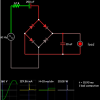Some power strips use LEDs. This one does:- **broken link removed**
The indicator was flickering quite noticeably, so I had a look inside. There are four LEDs around the switch button, and they are run from a resistive dropper and a diode with around 1 mA. There was no smoothing, so the flicker was 50 Hz, which is really obvious to me.
Also, the four LEDs are in two strings, each with a resistor. The four LEDs are evenly spread around the switch, at 90° gaps. One string contains the two LEDs at the 0° and 180° positions, and the other has the 90° and 270° positions. The two strings are also the same polarity, so they light on the same half of the mains cycle. Any idea why the design with two strings, which therefore uses twice the power? Could it be that it was intended to have the two strings on opposite polarities to reduce flicker?
I've changed my one to a single string and added a smoothing capacitor.




